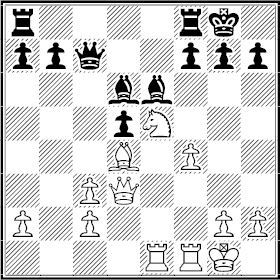
A positional blunder violates the nature of the pawn structure.
Ratmir Kholmov White
Valery Korensky Black
Kharkov 1967
Petroff Defense C43
1 e4 e5 2 ♘f3 ♘f6 3 d4 ♘xe4 4 ♗d3 d5 5 ♘xe5 ♗d6 6 0-0 0-0 7 ♘c3 ♘xc3 8 bxc3 ♘d7
Black challenges the e5-knight but also considers a shift of his own knight to e4 or a4.
9 f4 c5!
After 10 ♕h5 ♘f6 11 ♕h4 c4! White’s pawns become vulnerable (12 ♗e2 ♗f5 or 12...♕a5 13 ♖f3 ♘e4).
10 dxc5!
White damages his pawns to clear d4 for his bishop, e.g. 10...♘xe5 11 cxd6! ♘xd3 12 cxd3 ♕xd6 13 ♗e3 and ♗d4.
10...♘xc5! 11 ♗e3 ♘xd3 12 ♕xd3 ♕c7 13 ♖ae1 ♗e6 14 ♗d4

Black’s superiority, based on the pawn structure, is clearer after 14...f6!. For example, 15 ♘f3 ♖fe8 16 f5 ♗f7 and ...♕a5 exposes the weak queenside pawns.
14...♗xe5??
But now his pawns don’t protect dark squares like g7.
15 ♖xe5 ♖fe8? 16 ♖g5! f6
Question 231: Is 16...g6 safer?
17 ♗xf6 g6 18 ♖xg6+! hxg6 19 ♕xg6+ ♔f8 20 ♕h6+ resigns.
It’s mate (20...♔g8 21 ♕h8+ ♔f7 22 ♕g7).
Viktor Kupreichik White
Mark Dvoretsky Black
Leningrad 1974
1 e4 e5 2 ♘f3 ♘f6 3 d4 ♘xe4 4 ♗d3 d5 5 ♘xe5 ♗d6 6 0-0 0-0 7 ♘c3 ♘xc3 8 bxc3 ♘d7 9 f4 c5 10 c4?! cxd4 11 cxd5 ♘f6 12 ♗c4 ♗c5 13 ♕f3 (13 ♗b2 ♘xd5 14 ♗xd4 loses material to 14…♘c3! 15 ♗xc5 ♘xd1 16 ♖axd1 ♕c7) ♗f5 14 ♖e1 ♕a5 15 ♗b2 d3+ 16 ♔h1 d2! 17 ♖e2 ♗xc2 18 ♘g4! ♘xg4 19 ♕xg4 g6 20 ♕g5 ♗a3 21 ♗e5 ♗c1! 22 h3 d1(♕)+ 23 ♔h2 ♖ae8 24 d6 ♗xf4+ 25 ♕xf4 ♕xe2 26 ♗b2 ♕ae5 White resigns.